What if you could install a sloped-roof solar array without penetration? What if you could ballast it, like on a flat roof?
It’s possible, according to Joe Byles, an aerospace engineer with a long resume in fluid mechanics and thermodynamics. His work has taken him to diverse industries and markets including the Department of Defense, NASA, big-box retail and, most recently, Lawrence Berkeley National Laboratory. He’s also an inventor—the type of scientist who lies awake at night, mentally tweaking ideas and imagining new concepts.
History has shown inventions are often the result of known facts that—on purpose or by accident— collide and create something new or better. Byles’ latest collision of ideas, in the form of a non-penetrating, sloped-roof solar mounting system for asphalt shingle roofs, could have far-reaching benefits for the solar industry—if it’s commercialized.
This solar panel is attached to a test roof without penetrations using a cross-linked polymer, an inflammable and relatively lightweight material. The panel can stay attached even in 130-mph winds. Credit: SolarPowerWorldOnline
The spark
Byles developed a passion for sustainability, and an interest in solar, while working with a Department of Energy grant to improve building thermodynamics using advanced roofing materials. Around the same time, he had been patenting ideas for asphalt shingle roofing.
The interests intersected when he watched roofers sit or kneel on polyurethane expanding-foam pads, which look a little like pillows, while working. He thought the pads were for their comfort, but he learned they provided safety, too. The pads stabilized workers, preventing slides or falls. In fact, some roofers wear shoes bottomed with the material, in effect cementing their every stance on a roof.
“I [learned about] the increasing friction coefficient effect,” Byles said. In short, the increasing friction coefficient effect is a function of two material pressing against each other, causing an increase in shared surface area. Certain polymeric materials, which are porous and expand at a cellular level under pressure, can have strong bonds that are increased under force, such as the weight of a roofer or the pressure of strong wind.
“You can take a 200-lb person, and he can sit on these pads, and he’s stuck, like a lizard is stuck on a glass building,” Byles said.
In a moment of inspiration, he thought:
“If we take this material and ballast a solar panel with it, like they ballast panels in a commercial solar installation, I wonder if we can make the physics work? So I did the calculations, and it worked on paper, theoretically.”
So Byles did what any good inventor would do—he made a prototype.
The test
Byles built several prototypes in his workshop, each with different polymer and ballast combinations, measuring the gripping effect each had on asphalt shingle roofing.
“In some of my preliminary adhesion testing, I used everything from high-power leaf blowers to mounting small sections on my truck and driving 100 mph on backroads to confirm the performance,” Byles said.
The result was a ballasted friction plate connected to a solar panel with L feet. The friction plate bottomed with a 3/16-in. thick, semi-rigid material that feels like a mousepad, Byles said. The material, a cross-linked polymer, is inflammable and relatively lightweight, about 6 lb/ft2 without a solar panel. (Solar panels run about 4 lb/ft2, for a total of 10 lb/ft2 on the roof with the ballast plate, evenly spread.)
The plate allows the installation of solar panels in mere seconds, without any need for roof penetrations. Wires can be managed with clips, similar to how it’s done with rail-less systems, Byles said, and bonding pins would keep the system grounded.
In-house tests showed a successful concept, so Byles has “marched through” the appropriate wind, fire and loading tests. Byles has been working with performance testing entity Intertek to successfully complete the industry standard UL 1703/2703 testing. One of those tests included wind, where it withstood severe 130-mph constant wind force. Byles explained how:
“You have the shingle, and then you have the cross-linked polymer with a cell structure to it so that as you increase weight or wind blows on it, it moves a little bit, but the cell structure is such that the more surface area that hits the asphalt shingle, the stronger the bond,” he said.
The friction plate stays in place in the same way a gecko can stay attached to a vertical window. The gecko has many thousands of fine hairs on its footpads. The trick, according to Byles, is that the composite surface area of the hairs is huge compared to the body mass of the gecko, letting it stay attached and walk up the side of a glass surface.
Reflecting that, the polymer material with an expanded cell structure represents a composite surface area much greater than the apparent area the friction plate is covering. In other words, what you see is not what you get when it comes to this technology.
The video of the wind testing process also shows, as part of another test, a panel-adorned friction plate on a sample roof, which is tilted at 45°. On top of the panel rests 60 lb of sandbags, with gravity pulling them downward. Impressively, the plate holds steady.
Solar Power World asked what would happen if it rained, concerned water would weaken the bond.
“Absolutely nothing would happen,” Byles said, noting the porous nature of the polymer. “I’ve used this material in some green roofing applications, and so I had to qualify that to a standard … Because it’s an open cellular structure, the rain can move through the cells, but you still have the contact between the roofing material and polymer.”
The future
The solar industry has taken an interest in Byles’ invention, he said, confirming that he is holding meetings with companies in both solar installation and manufacturing. It’s clear why they’re interested: If the technology is commercialized and the market accepts it, it could be an instant game-changer.
“[A supplier could] take this technology, go to their installer base and say, look, we have this technology, there will be no penetrations, and your own roof labor will be reduced by 95%, so you can do many more jobs and achieve a better end product for your customers,” Byles said.
The Texas-based inventor points to several other ways his invention could help the industry. Removing the need to penetrate a roof is the most obvious. The possibility of leaks is a key concern among homeowners.
A system without the added material and labor costs associated with roof penetrations would also reduce costs and length of ROI, “democratizing solar,” Byles said. And when a customer is prepared to sell his or her house, or re-roof, a system without attachments would be simple to move. Installers would only need to lift each panel off the roof, just the way they set it down. Byles does not, however, a slight Velcro-like effect between the polymer and rough surface of the asphalt shingles.
He makes no secret about his enthusiasm for the product, but notes that he’s working on “Ten other ideas,” as well. Still, it’s clear he has a view of the solar industry and how this product could help.
“The industry has gone from conventional mounting to shared rails, and now rail-less. That’s the way the industry is moving to reduce parts and labor, and that makes sense,” Byles said. “I’ve spent a lot of time on these roofs, and it’s not a fun place to be with tools.”
Residential solar installation without a need for tools? It could happen soon. And as if that weren’t enough, Byles offers a “moonshot vision,” too:
“Ultimately, I envision this thing as an omni-panel, all built on ground,” Byles said. “An autonomous panel, with a battery backup replacing the ballast material, a microinverter. It would be a complete mounting system with battery storage, all of which you install in 10 seconds. That’s the future, but it’s possible with this system.”
Reference:
This article has been published here with permission by the PVBuzz Media team from the original article written by Steven Bushong and published on SolarPowerWorldOnline.
















Comments